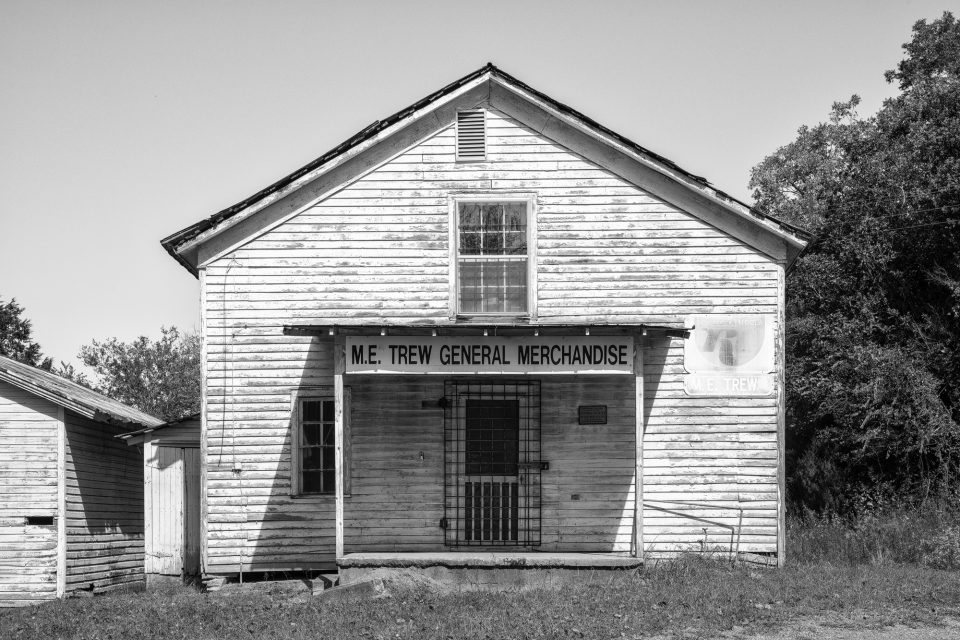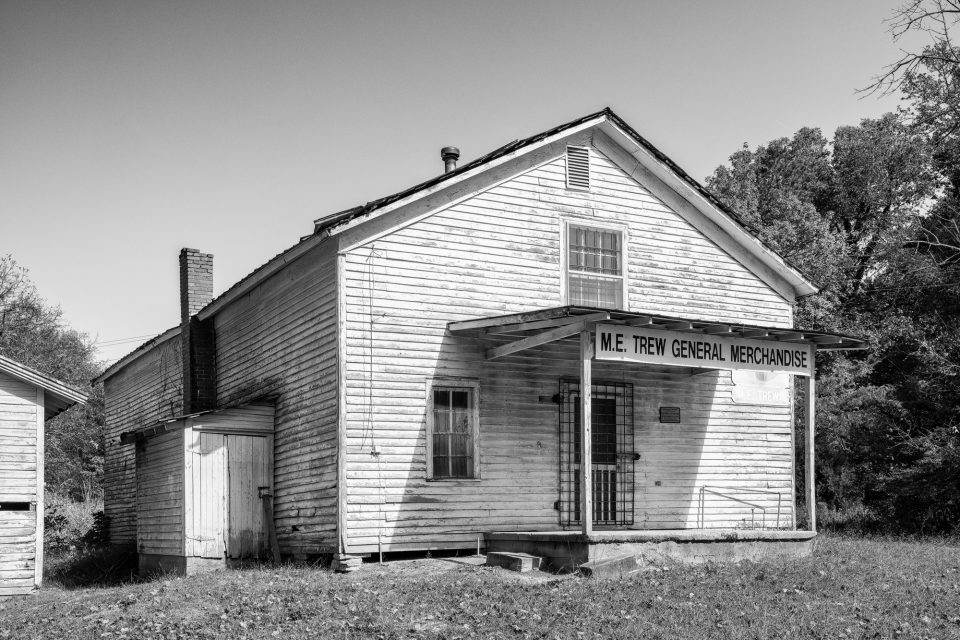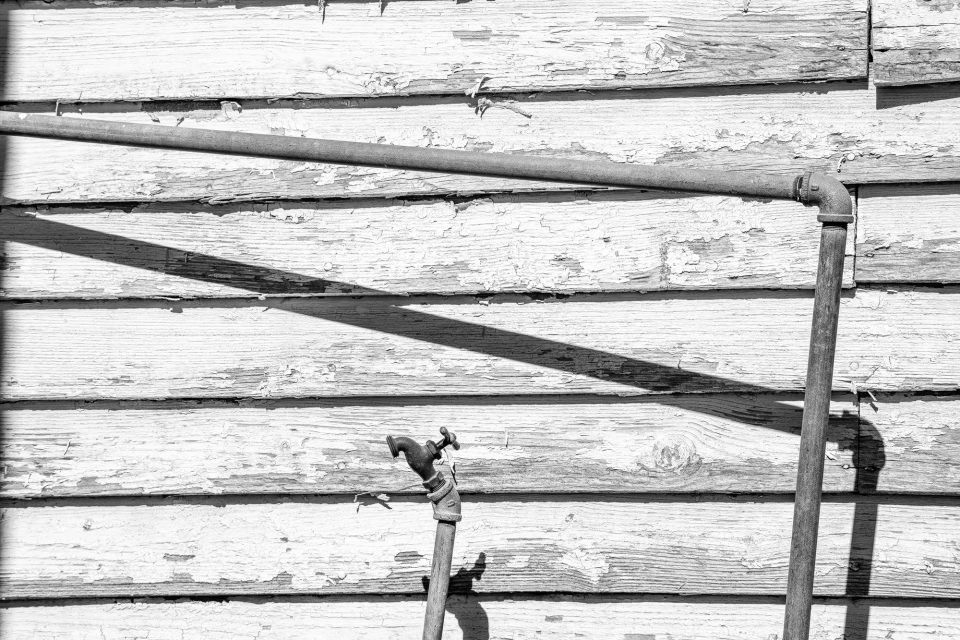Fine art photographer Keith Dotson tells the story of an old country store found along a backroad in the East Tennessee mountains
Country stores were a valuable resource for rural people in the days before supermarkets, big box stores, or even cars were commonplace. Shoppers could buy food, ammunition, farm supplies and implements, hardware, nails, headache medicine, hats and shoes, candy, and swathes of fabric.
But stores were also a place to pick up mail and catch up on news. They were a place to relax over a game of checkers while having a cold Coke or RC Cola. They were a place to meet friends and relatives and catch up on local gossip.
Some of the merchants, like the M.E. Trew General Merchandise Store, extended hundreds or even thousands of dollars of credit to local farmers while they waited for the crops to be harvested.
The land was purchased in the 1830s by a man from Kentucky named Dr. Thomas Trew. The family established a farm and various businesses run by Dr. Trew’s grandsons: a saw mill, a threshing machine, a cotton mill, a flour mill, and a family farm.
In 1890 John W. Trew opened the general store in the smaller building located on what’s now called Highway 163. The second, larger building was opened in 1903.
J.W. Trew died in 1941, and the store was then owned in partnership by his five sons, one of whom — Mortimer E. Trew began managing the store under the name Trew Brothers in 1925. He became the sole proprietor in 1975 and changed the name to M.E. Trew General Merchandise. Mortimer Trew operated the store with his wife until he died on April 1, 1996.
Meet Mrs. and Mrs. Trew
Here’s a real treat — watch a video segment about the store when it was still in business and being run by the Trew’s in 1994:
Facebook Video: The Heartland Series — Trew’s Store
After her husband died, Mrs. Trew didn’t want to continue operating the store on her own, so it was closed permanently. The Trew’s son bought the property to preserve the place where his parents had spent their lives, and where he had many childhood memories. He said he had boyhood memories of the mountain people coming down to shop at the Trew store because many of them couldn’t count, and they knew the Trew’s would give them a fair price and were honest in counting out the change given back to them.
According to a television news feature about Trew’s Store, it was famous in its day for bologna and cheese sandwiches, made by Mrs. Trew with bologna sliced on the spot, Wisconsin cheddar cheese, and fresh tomatoes pulled from her own garden.
In that video, M.E. Trew recalls selling shoes in 1930 for $1.98 a pair, but they were $55 when this video was recorded in 1994. He said in past decades they traded goods for chickens and rabbits. As the television announcer said in the feature, ammo and Brillo, brake fluid, and spices shared space on the long rows of dusty wooden shelves.
The store served as a gathering place — a center for the community. I witnessed this myself. Even though the store has been closed since 1996, two cars arrived in the dusty gravel parking lot while I was on location making photographs. They were family members taking a few minutes to meet at a convenient location. They didn’t even seem to notice that I was there.
Watch a 360-degree video of the inside of the abandoned store
Trew’s Store was nominated to the National Register of Historic Places in 1976
Full text from the National Register of Historic Places Nomination Form for the M.E. Trew General Merchandise Store
The following two sections are quoted verbatim from the nomination form, submitted in 1976.
Description
These store buildings are characterized by their grouping. As two separate structures they share similarities in their rectangularity, wide gable roof design and fairly simple fenestration. Aligned in identical orientation, the extremely plain architectural style of these commercial buildings is devoid of extraneous detail or prevailing stylistic effects. The emphasis of function and economy of materials is expressed by their box-like, windowless side wall which allows for a maximum of uninterrupted wall space for interior rooms.
The only source for natural light comes in the gable end fenestration. The purpose for the large windows in the gable-end of the two-story building is to provide a source of light from the loft which is designed as an open balcony or cat-walk extending across each elevation of the one room interior space. The attached utility shed, brick store chimneys, hooded stoop and attached shed roofed porch seem entirely functional by their appointment. The split-level design of the original 1890 store indicates the lower half served as a separate, stock room. The open cat-walk in the 1903 store building was designed to function as a stock room.
The interior design of the present store is authentic in every detail. The room is divided into aisles by the 9′ x 4′ solid oak tables built for the store by Mr. Tom Walker. Constructed and finished in oak, the interior has remained unfinished, unvarnished and unpainted. The walls are paneled with oak siding and the various types of shelves and bins are custom-made sizes and shapes which are typical of the building practices for this type of use.
Any modern effect created by the presence of new fixtures, advertising displays, or refrigerated cases for perishable items is coincidental to the long-standing practice of hanging colorful merchandise and advertisements from every convenient elevation. Over the years the interior has become a gallery for displaying many unusual items, presently considered to be antiques. This colorful array, lit by bare-bulb light fixtures, includes a continuous display of posters like those for “Wine of Cardui,” RRed-Seal Snuff,” “Tedfords Black Draught for Liver Ailments,” etc. These posters are intersected at every convenient’ interval by every type and description of merchandise including such items as washboards, horse collars, pots, pans, cast-iron ware, tubs, buckets, tins, bins, mops, brooms, motor belts, coal buckets, gasoline cans and tall, well buckets.
Where order does exist, there seems to be a basic plan designed to provide departments for at least four types of goods. Pigeon-hole shelves, regular shelves, counter tops and bins are provided for hardware items. Adjacent to the door is a large galvanized tank for dispensing stove oil. At the corner nearest the door there is a bookkeeper area where the antique wall phone, combination-lock floor safe, medium size rolltop desk and storekeeper’s stool are located. Store catalogues and records kept in this desk date from 1890.
The long cash register counter is shared with a delightful, glass-fronted, Oak candy case and an antique cheese slicer (Complete at all times with a round of fresh Cheddar). Also, on this counter, there are such items as the old tobacco cutter, antique calculator, modern motorized meat slicer and the antique “Simpson Computing Scales”. Mr. Trew adheres to the practice of stocking stone ground flour and meal, raw honey and oak barrels for brown sugar and coffee sold by the pound weight.
Perhaps the most colorful area is the dry goods section extending across one side opposite the grocery section. Open shelves are piled high with bolts of linens and calico fabric, work clothes, boots and shoes. The long tables are laden with colorful items, hand«made quilts, straw or floral printed fabric and garden hats. The first dress shirt ever sold in the store hangs from one of the walls.
The cat-walk balcony is reached by a wooden staircase built in one corner opposite the front entrance. This gallery space is piled high with every assortment of boxed merchandise items.
In cold weather the interior is heated by the wood stove located in the wide center aisle opposite the present front deor. Pulled up around the stove are a varied assortment of chairs, benches, boxtops and stools which are usually occupied by customers who congregate there to rest or to engage in conversation with one another.
Statement of Significance
M. E. Trew General Merchandise Store, established by John W. Trew, is located on a portion of the original land purchase initiated by Dr. Thomas Trew who moved to McMinn County from Kentucky in 1835. The Trew farmstead is one of 34 Century Farms, so honored for continuously being farmed by the same family for more than one hundred years. Dr. Thomas Trew had an interest in a threshing machine before the Civil War, and his descendents operated the first wheat threshing machine in the county. “The Trews threshed wheat and oats for other farmers for over one hundred years. John Wesley Trew had two threshing machines in operation until 1957.
Passing from father to son, the family businesses were expanded as they were undertaken by each of J. W. Trew’s five sons. J. W. Trew was a co-founder of the Eureka Cotton Mill in 1911. The Trew cotton gin, in operation from 1901-1969, was run by his son, J. H. Trew. Purchased in 1930, the flour mill was operated by Abe Trew until 1952. The saw mill operated from 1905 to 1975. Fred Trew managed the family farm until 1954. Typical of agriculture in this area, the Trews raised wheat, oats, cotton, corn and soybeans as well as raising dairy and beef stock. All of these enterprises added to the economy of the agrarian-based society.
In 1890 John W. Trew opened the general store in the smaller, one-story building located on the Bowaters Road at Dentville, a community named for his grandfather, Dent Porter. After his death in 1941, the J. W. Trew Store was owned in partnership by his five sons. Mortimer E. Trew began managing the family business in 1925. The store was known as “Trew Brothers” until he became owner and sole proprietor in 1975. He had purchased locally-grown cotton from 1928 to 1969 when the gin closed.
Mortimer E. Trew is a sixth generation descendent of one of Tennessee’s most revered citizens, Colonel Return Jonathan Meigs. In 1836 Meigs County was named for Col. Meigs who was a distinguished soldier in the Revolutionary War. He became a major force in dealing with the Cherokee Indians. Acting as an Indian agent from 1801- 1823, he earned his fame in Tennessee.
Cotton was the major cash crop at the turn of the century. The new gin was built in 1919, and it was in use when the Depression brought about hard times for the local farm families. Trew’s General Store helped sustain the local economy, and, by agreement, the store carried thousands of dollars credit for their customers who lived on the income of their cotton crops.
Representative of a rural way of life, the charm of this country store is characterized by that rare informality where neighbor meets neighbor, a custom that has continued here for generations. The customers have formed a group that has been together for a lifetime. As a social institution this general store is a place where business and pleasure are practiced on a leisurely basis. Many good times have been enjoyed by young and old who gather around the old “King of Heat” wood stove to pass the time of day.
Carefully preserved records dating from the 1890 period serve as documentation for a page in the history of American merchandising and commerce. The store catalogue, inventory of goods, daily receipts and other memorabilia reflect the change in supply and demand for the local patrons. These records also list names of customers and reflect their business transactions and buying habits.
Authentic examples of the country type general merchandise store have all but disappeared from the face of rural America in recent years. The architectural significance of these buildings is derived from their functional design. Devoid of any stylistic influence, the design is characteristic of their intended use. These commercial-type structures represent the form of building construction practiced during the turn of the century in rural America. Passing from father to sons, this store is the longest surviving general merchandise store in McMinn County, and one of the few continuously operating stores to have retained its original form, authenticity, and value as the principal gathering place for the community.
— End of the text from the National Register of Historic Places form —
Black and white photographs of the Trew General Merchandise Store
Fine art prints are available on museum-quality paper in a wide variety of sizes.





Sources
facebook, WBIR The Heartland Series, “The General Store”
National Register of Historic Places, Inventory Nomination Form, Trew General Merchandise Store
National Register of Historic Places, Photographic Assets, Trew General Merchandise Store
WBIR Channel 10 News, “Abandoned Places: Trew’s Store”
